Bistos BT-720 User Manual
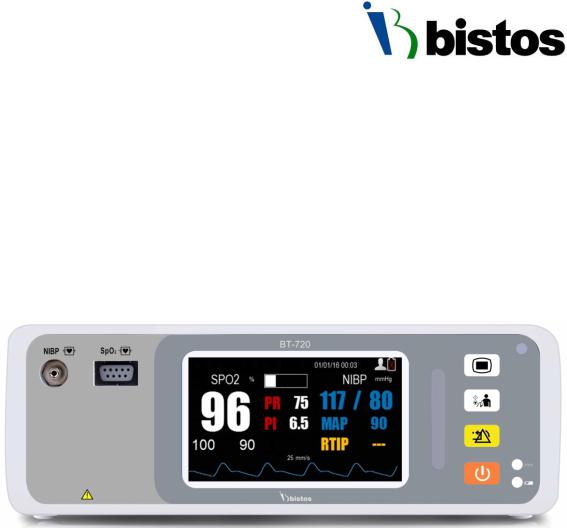
BT-720 Patient monitor
Operation Manual
Keep this manual for future reference
P/N : 720-ENG-OPM-EUR-R01
BT-720 Operation manual |
1 |
|
|
Proprietary Material
Information and descriptions contained in this manual are the property of Bistos Co., Ltd. and may not be copied, reproduced, disseminated, or distributed without express written permission from Bistos Co., Ltd.
Information furnished by Bistos Co., Ltd is believed to be accurate and reliable. However, no responsibility is assumed by Bistos for its use, or any infringements of patents or other rights of third parties that may result from its use. No license is granted by implication or otherwise under any patent or patent rights of Bistos Co., Ltd.
The information contained herein is subjects to change without notice.
Prepared by:
Bistos Co., Ltd.
7th FL., A Bldg., Woolim Lions Valley 5-cha,
302, Galmachi-ro, Jungwon-gu, Seongnam-si,
Gyeonggi-do, Korea
Telephone: +82 31 750 0340
Fax: +82 31 750 0344
Revision R01
June, 2019
Printed in Korea
Copyright © Bistos Corporation 2018. All rights reserved.
|
|
|
P/N : 720-ENG-OPM-EUR-R01 |
Bistos Co., Ltd. |
2019.06 |
BT-720 Operation manual |
2 |
|
|
Contents
0.Safety information ······················································································ 4
0.1General precautions, warnings and cautions ···························································· 6
0.2Shock hazards ············································································································· 9
0.3Battery warnings········································································································· 10
0.4General precautions on environment ······································································· 11
1.System basics ······························································································ 12
1.1Intended use ··············································································································· 12
1.2Operating principle ····································································································· 13
1.3System configurations ································································································ 13
1.4Product outlook ·········································································································· 15
1.5Description of monitor ······························································································· 16
1.6Understanding the display ························································································· 17
1.7Essential performance ································································································ 18
2.Preparing for operation ··············································································· 19
2.1Installation ·················································································································· 19
2.2Connecting to power ·································································································· 21
3.Basic operations ·························································································· 22
3.1Turn on ························································································································ 22
3.2Turn off ······················································································································· 23
4.Setup the monitor ······················································································· 24
5.SpO2 ··········································································································· 26
5.1Overview ····················································································································· 26
5.2Safety information ····································································································· 26
5.3Monitoring steps ········································································································ 27
5.4Setting SpO2 ················································································································ 28
5.5Measuring influencing factors ···················································································· 29
5.6Technical description ································································································· 30
6.NIBP ··········································································································· 31
6.1Overview ····················································································································· 31
6.2Safety information ····································································································· 31
6.3Measurement limits ··································································································· 32
6.4Measurement procedure ··························································································· 34
6.5Setting NIBP ················································································································ 35
6.6Clean and disinfection method of NIBP cuff ······························································ 37
7.Review ········································································································ 38
8.Alarm ·········································································································· 40
9.Battery ······································································································· 41
|
|
|
P/N : 720-ENG-OPM-EUR-R01 |
Bistos Co., Ltd. |
2019.06 |
BT-720 Operation manual |
3 |
|
|
9.1Overview ····················································································································· 41
9.2Battery usage guide ···································································································· 41
9.3Checking battery performance ·················································································· 42
9.4Battery recycling ········································································································· 42
10.Caring and cleaning ····················································································· 44
10.1Overview ·················································································································· 44
10.2Cleaning ···················································································································· 44
10.3Disinfection ·············································································································· 45
11.Maintenance ······························································································ 46
11.1Checking ··················································································································· 46
11.2Maintenance plan ···································································································· 47
12.Accessories ································································································· 48
13.Specifications ······························································································ 49
13.1Safety specification ·································································································· 49
13.2Hardware specifications ··························································································· 50
13.3Functional specification ··························································································· 51
14.Common faults and maintenance ································································ 53
15.Manufacturer’s declaration on EMC ···························································· 54
15.1Electromagnetic emissions ······················································································· 55
15.2Recommended separation distances between portable and mobile RF communications equipment and BT-720 ····································································································· 56
15.3Electromagnetic immunity ······················································································· 57
Product Warranty ······························································································ 59
Figure 1-1: Front view ············································································································ 15 Figure 1-2: Rear view ············································································································· 15 Figure 1-3: Front view ············································································································ 16 Figure 1-4: Rear view ············································································································· 17 Figure 1-5: Standard display ·································································································· 17 Figure 7-1: SpO2 trend(1) ······································································································ 38 Figure 7-2: SpO2 trend(2) ······································································································ 38
|
|
|
P/N : 720-ENG-OPM-EUR-R01 |
Bistos Co., Ltd. |
2019.06 |
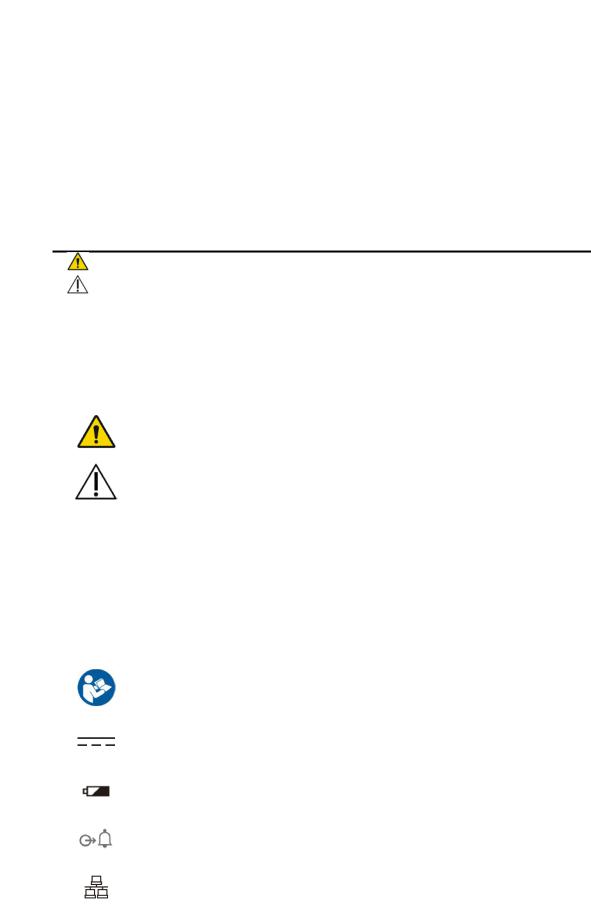
BT-720 Operation manual |
4 |
|
|
0 Safety information
Before using BT-720 Patient monitor, read this entire manual and be fully understood the following safety information to prevent injury of patient and user.
Symbols Used
The following symbols identify all instructions that are important to safety. Failure to follow these instructions can lead to injury or damage to the patient monitor. When used in conjunction with the following words, the symbols indicate:
WARNING |
Can lead to serious injury or death. |
CAUTION |
Can lead to minor injury or product/property damage |
The following symbols are placed on product, label, packaging and this manual in order to stand for the information about:
IPX1
IPX2
Used to identify safety information.
Be well-known this information thoroughly before using BT-720.
Used to identify safety information.
Be well-known this information thoroughly before using BT-720
Indicates the protection level against the ingress of liquid. IPX1 is protection against some water drops falling vertically. It correspond the device, patient monitor.
Indicates the protection level against the ingress of liquid.
IPX2 is protection from some water drops when the device is tilted up to and including 15°.
It correspond the accessories for SpO2.
Refer to operation manual. Read manual before placing the device.
Indicates DC power supply.
Indicates the device is in the battery operation mode.
Indicates nurse call interface.
Indicates network interface.
|
|
|
P/N : 720-ENG-OPM-EUR-R01 |
Bistos Co., Ltd. |
2019.06 |

BT-720 Operation manual |
5 |
|
|
Indicates USB interface.
Indicates power adapter polarity.
Indicates the production date.
Indicates the manufacturer.
Indicates the serial number of the device.
Indicates the authorized representative in the European Community of manufacturer.
Indicates a defibrillation-proof type BF applied part.
Indicates a defibrillation-proof type CF applied part.
Indicates CLASS II equipment.(Adapter)
Indicates the date after which the medical device is not to be used.
Indicates to keep the device dry.
Indicates the medical device that can be broken or damaged if not handled carefully.
Indicates to keep upright
Indicates the maximum stacking limit.
Indicates the temperature limitation for operation, transport and storage.
Indicates the humidity limitation for operation, transport and storage.
Indicates the range of atmospheric pressure to which the medical device can be safely exposed.
|
|
|
P/N : 720-ENG-OPM-EUR-R01 |
Bistos Co., Ltd. |
2019.06 |

BT-720 Operation manual |
6 |
|
|
Indicates the device contains natural rubber latex.(Accessories)
Indicates the packing material is recyclable.
Indicates to not dispose the device together with unsorted municipal waste(for EU only). The solid bar symbol indicates that mains adapter is put on the market after 13 August 2005.
0.1 General precautions, warnings and cautions
•Examine the patient monitor and any accessories periodically to ensure that the cables, adapter cords and instruments do not have visible evidence of damage that may affect patient safety or performance. The recommended inspection interval is once per week or less. Do not use the patient monitor if there is any visible sign of damage.
•Only the DC power adapter supplied with the BT-720 is approved for use with the device.
•Do not attempt to service the BT-720 patient monitor. Only qualified service personnel by Bistos Co. Ltd. should attempt any needed internal servicing.
•Perform periodic safety testing to insure proper patient safety. This should include leakage current measurement and insulation testing. The recommended testing interval is once per year.
•If the hospital or healthcare institutions using this device fail to implement a satisfactory maintenance schedule, it will result in device failure and may endanger the patient’s safety.
•Use the patient monitor under the conditions specified in this operation manual. Beyond the conditions, the patient monitor may not function properly and the measurement results may not accurate and may result in device failure or endangering the patient’s safety.
•Do not operate the BT-720 patient monitor if it fails to pass the power on self-test procedure.
•During the operation, do not disconnect any cable.
•The BT-720 patient monitor is intended to be used by clinical professionals or trained doctors, nurses or laboratory assistant.
•Do not service and maintain or clean the device including accessories while in use with a patient.
|
|
|
P/N : 720-ENG-OPM-EUR-R01 |
Bistos Co., Ltd. |
2019.06 |

BT-720 Operation manual |
7 |
|
|
•Using the device to one patient at a time.
WARNING
•Thoroughly read and understand the manual prior to use of the BT-720. Failure to do so could result in personal injury or equipment damage.
•The device is intended for clinical patient monitoring, and only trained and qualified doctors and nurses should use the device.
•The alarm volume, upper and lower alarm limits should be set according to the actual situation of the using environment. Do not just rely on audio alarm system while monitoring the patient, because too low alarm volume or muted alarm may result in notice failure of alarm situation and endanger the patient’s safety. Please pay close attention to the actual clinical status of the patient.
•Use only the power adapter supplied with monitor.
•Position the monitor where it is easy to de-energize the monitor when needed.
•Do not open the enclosure to avoid an electric shock. Any repair and upgrade of monitor should be done by service personnel trained and authorized by Bistos. Co., Ltd.
•When handling packaging materials, abide by local laws and regulations or hospital waste disposal regulations. Keep the packaging materials away from children.
•Do not use in the presence of flammable anesthetics to prevent explosion or fire.
•Install the power lines and cables of accessories carefully to avoid patient entanglement or suffocation, cables tangled or electrical interference.
•When the monitor is used together with electrosurgical devices, the user (a doctor or a nurse) should ensure the safety of the patient and instrument.
•The physiological wave, physiological parameters and alarm information displayed on the monitor are only for the doctor’s reference and should not be directly used as the basis for clinical treatment.
•This is not a therapeutic device.
•For patients with pacemakers, the cardio tachometer may count the pacemaker pulse in case of a cardiac arrest or arrhythmias. Never rely solely on the cardio tachometer alarm. Closely monitor the patients with pacemaker. For the inhibition of the device on pacemaker, refers to this manual.
•Use of accessories other than those listed and approved for use with this product may result in increased emissions or decreased immunity.
•Medical electrical equipment needs special precautions regarding EMC and needs to be installed and put into service according to the EMC information
|
|
|
P/N : 720-ENG-OPM-EUR-R01 |
Bistos Co., Ltd. |
2019.06 |
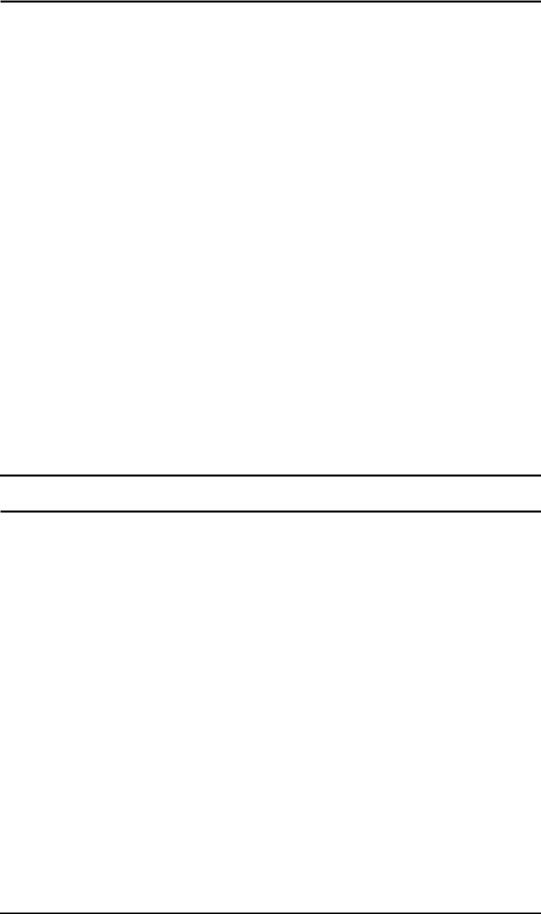
BT-720 Operation manual |
8 |
|
|
provided in this manual. In addition, portable and mobile RF communications equipment can affect medical electrical equipment.
•The equipment shall not be used adjacent to other devices unless verification of normal operation in the configuration in which it is to be used can be achieved.
•Keep matches, and all other sources of ignition, out of the room in which the patient monitor is located. Textiles, oils, and other combustibles are easily ignited and burn with great intensity in air enriched with oxygen. Personal injury or equipment damage could occur.
•A fire and explosion hazard exists when performing cleaning or maintenance procedures in an oxygen-enriched environment.
•The patient monitor has been validated with the accessories and options listed in this manual and found to comply with all relevant safety and performance requirements applicable to the device. It is therefore the responsibility of the person or organization who makes an unauthorized modification, or incorporates an unapproved attachment to the device.
•An operator may only perform maintenance procedures specifically described in this manual.
•Do not remove the covers of a BT-720 yourself to avoid damage to the equipment and unexpected electrical shock. Only qualified Bistos service engineer must repair or replace components.
 CAUTION
CAUTION
•Please install or carry the instrument properly to prevent damage due to falling, collision, strong vibration or other mechanical force.
•Avoid instrument splashed by water.
•Avoid high temperatures, the instrument should be used within a temperature range of 5 ~ 40
•Avoid using instrument in the environment such as pressure is too high, poor ventilation, dusty, or contain salt, sulfur gas and chemical.
•Before using the monitor, check the monitor and accessories if there is damage that may affect patient safety. If there is obvious damage or aging, replace the parts before use. The replacement should be made with same parts of original parts.
•Before powering on the device, make sure that the power used by the device complies with the supply voltage and frequency requirements on the equipment label or in the Operator’s Manual.
|
|
|
P/N : 720-ENG-OPM-EUR-R01 |
Bistos Co., Ltd. |
2019.06 |

BT-720 Operation manual |
9 |
|
|
•Equipment should be tested at least once a year, the test should be done and recorded by trained, have security testing knowledge and experienced personnel. If there are any problems in the tests, they must be repaired.
•When the instrument and accessories are about to exceed the useful life (expected service life: 5 years), it must be treated in accordance with relevant local laws and regulations or the hospital's rules and regulations.
•Do not connect to other equipment or network which not specified in the instruction for use, in risk of external high voltage.
•Do not connect any equipment or accessories that are not approved by the manufacturer or according to IEC 60601-1 to the monitor. The operation or use of non-approved equipment or accessories with the monitor is not tested or supported, and monitor operation and safety are not guaranteed in such a case.
•Any non-medical equipment (such as the external printer) is not allowed to be used within the patient vicinity (1.5m/6ft.).
•Parts and accessories used must meet the requirements of the applicable safety standards, and/or the system configuration must meet the requirements of the medical electrical systems standard.
•Ensure that the conductive parts of electrodes and associated connectors, including neutral electrodes, do not come in contact with earth or any other conducting objects.
•Protection of ME EQUIPMENT against effects of discharge of a cardiac defibrillator depends on use of proper cables.
0.2 Shock hazards
WARNING
Unplug the monitor from its power source prior to cleaning or maintenance to prevent personal injury or equipment damage.
Some chemical cleaning agents may be conductive and leave a residue that may permit a build-up of conductive dust or dirt. Do not allow cleaning agents to contact electrical components and do not spray cleaning solutions onto any of these surfaces. Personal injury or equipment damage could occur.
Do not expose the unit to excessive moisture that would allow for liquid pooling. Personal injury or equipment damage could occur.
Do not touch the patient and signal input/output parts simultaneously
Due to the risk of electrical shock hazard, only qualified personnel with appropriate
|
|
|
P/N : 720-ENG-OPM-EUR-R01 |
Bistos Co., Ltd. |
2019.06 |

BT-720 Operation manual |
10 |
|
|
service documentation should service the monitor.
0.3 Battery warnings
WARNING
Improper operation may cause the internal lithium ion battery to be hot, ignited or exploded, and it may lead to the decrease of the battery capacity. It is necessary to read the operation manual carefully and pay more attention to warning message.
Do not open the battery compartment. Only the qualified service personnel authorized by the manufacturer can open the battery compartment and replace the battery, and batteries of same model and specification should be replaced.
Be careful when connecting the battery with polarity.
Do not use the battery near fire or environmental temperature exceeds 60 . Do not heat or splash the battery or throw it into fire or water.
Do not destroy the battery. Do not pierce battery with a sharp object such as a needle. Do not hit with a hammer, step on or throw or drop the battery. Do not disassemble or modify the battery. The battery can heat, smoke, deformation or burning.
When leakage or foul smell is found, stop using the battery immediately. If your skin or cloth comes into contact with leaked liquid, cleanse it with clean water at once. If the leaked liquid splashes into your eyes, do not wipe them. Irrigate them with clean water first and go to see a doctor immediately.
Properly dispose of or recycle the depleted battery according to local regulations.
|
|
|
P/N : 720-ENG-OPM-EUR-R01 |
Bistos Co., Ltd. |
2019.06 |
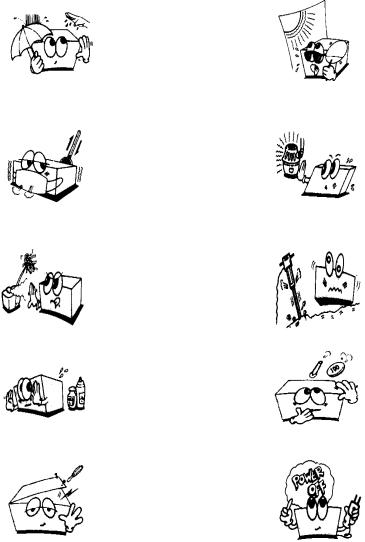
BT-720 Operation manual |
11 |
|
|
0.4 General precautions on environment
Do not keep or operate the equipment under the environment listed below.
|
Avoid placing in an area |
|
Avoid exposure to direct |
|
exposed to moisture. Do |
|
|
|
not touch the equipment |
|
sunlight |
|
with wet hand. |
|
|
|
|
|
|
|
Avoid placing in an area |
|
|
|
where high variation of |
|
|
|
temperature exists. |
|
Avoid in the vicinity of |
|
Operating temperature |
|
|
|
|
electric heater. |
|
|
ranges from 5 ~ 40 . |
|
|
|
|
|
|
|
Operating humidity |
|
|
|
ranges from 30 % ~ 85 %. |
|
|
|
|
|
|
|
Avoid placing in an area |
|
Avoid placing in an area |
|
where there is an |
|
where there is an |
|
excessive humidity rise |
|
excessive shock or |
|
or ventilation problem. |
|
vibration. |
|
|
|
|
|
Avoid placing in an area |
|
Avoid dust and especially |
|
where chemicals are |
|
|
|
|
metal material enter into |
|
|
stored or where there is |
|
|
|
|
the equipment |
|
|
in danger of gas leakage. |
|
|
|
|
|
|
|
|
|
|
|
Do not disjoint or |
|
Power off when the |
|
|
equipment is not fully |
|
|
disassemble the device. |
|
ready to operate. |
|
Bistos Co., Ltd. does not |
|
Otherwise, the |
|
have liability of it. |
|
equipment could be |
|
|
|
damaged. |
|
|
|
|
|
|
|
P/N : 720-ENG-OPM-EUR-R01 |
Bistos Co., Ltd. |
2019.06 |

BT-720 Operation manual |
12 |
|
|
1 System basics
1.1 Intended use
The BT-720 Patient Monitors acquire the physiological signals for non-invasive blood pressure (NIBP), pulse rate (PR) and blood oxygen saturation (SpO2). The signals are converted into digital data and processed, examines the data for alarm conditions and display the data. The monitor also provides operating control for the user. The patient monitor intend to use in hospital clinical area such as intensive care units, operating room, emergency department, to provide additional information to the medical and nursing staff about the physiological condition of the patient. The BT-720 patient monitors are intended to be used only under regular supervision of clinical personnel. It is suitable for adult and pediatric, neonate. The intended locations of use are hospitals and clinics.
1)Intended patient population
-Adult (>18 years adults) and Pediatrics (30 days < and <18 years) and Neonate (0 days and 30days)
2)Intended user profile
-Doctor, physicians or nursing staff who is qualified personnel
-Basic experiences or knowledge on medical field, especially on patient monitoring
-Trained or requested to read IFU before use
3)Environment of use
-Hospital and clinic
-Requirements: Stable power source
4)Scope of application
This monitor is suitable for bedside monitoring of patient. This monitor enables blood oxygen saturation (SpO2), pulse rate (PR) and monitoring. It is equipped with a replaceable built-in battery to provide convenience for the patient movement in hospital.
5) Indications and contraindications
Blood oxygen saturation (SpO2)
Indication:
-Monitoring effectives of oxygen therapy
-A reading is needed to facilitate the completion of an early warning score to inform clinical assessment
-Sedation or anesthesia
-Transport of patients who are unwell and require oxygenation assessment
-Haemodynamic instability (e.g. cardiac failure or Myocardial Infarction)
|
|
|
P/N : 720-ENG-OPM-EUR-R01 |
Bistos Co., Ltd. |
2019.06 |
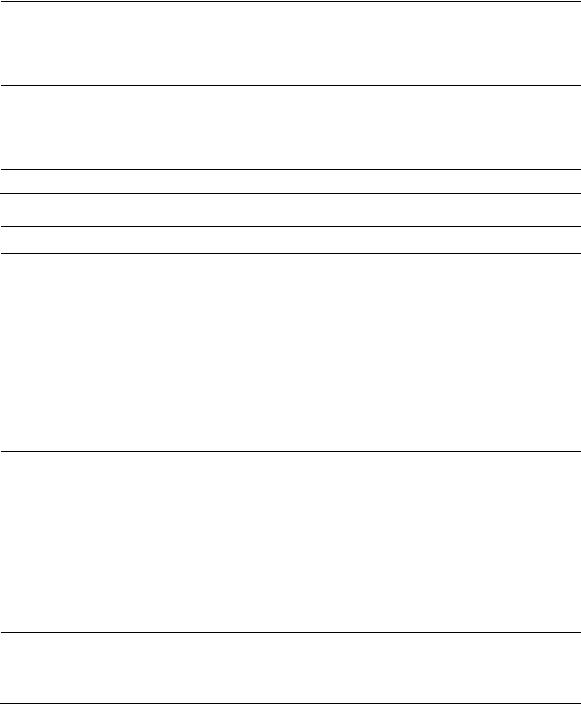
BT-720 Operation manual |
13 |
|
|
-Respiratory illness e.g. asthma, chronic obstructive pulmonary disease
-Monitoring during administration of respiratory depressant drugs, e.g. opiate epidural or patient-controlled analgesia.
-Assessing oxygen saturation during physical activity e.g. in pulmonary rehabilitation
Contraindications
-Pulse oximetry does not give an indication of haemoglobin so if the patient is profoundly anaemic then their oxygen saturation may by normal but they may still be hypoxic
Source: NHS. “Clinical Procedure_ Procedure for Pulse Oximetry/SPO2”. Wirral Community NHS Trust. Sep, 2013
Non-invasive blood pressure (NIBP)
Indication:
-To determine a patient’s blood pressure
-Screen for hypertension
-Following the effect of anti-hypertensive treatments in a patient to optimize their management
-Assessing a person’s suitability for a spot or certain occupations
-Estimation of cardiovascular risk
-Determining for the risk of various medical procedure
-Figuring out whether a patient is clinically deteriorating or is at risk.
Contraindications
-Oscillometric blood pressure devices may not be accurate in patients with weak or thready pulse
-In patients with heart beats below 50 beats/minutes, even if the rhythm is regular, some of the semi-automatic devices are unable to reduce their deflation rate sufficiently so that too rapid a falling in cuff pressure results in underestimation of systolic blood pressure and overestimation of diastolic blood pressure.
-Do not apply to limb with AV fistula, significant injury or burn, or lymph node removal post mastectomy.
Source: [1] NHS. “Clinical Procedure_ Procedure for Blood Pressure Monitoring”. Wirral Community NHS Trust. Dec, 2013
[2] Clinical Quality& Patient Safety Unit, QAS. Clinical Practice Procedures: Assessment/Non-invasive blood pressure. Queensland Government, 2016. https://www.ambulance.qld.gov.au/clinical.html
1.2 Operating principle
Refer to the chapters for every physiological parameter from chapter 5 to chapter 6.
1.3 System configurations
Basic configuration of BT-720
|
|
|
P/N : 720-ENG-OPM-EUR-R01 |
Bistos Co., Ltd. |
2019.06 |

BT-720 Operation manual |
14 |
|
|
•Main body with 4.3” touch screen and built-in lithium-ion battery
•Adult SpO2 probe and extension cable
•AC/DC adapter
Options of BT-720
•Non-invasive blood pressure cuff
Picture |
|
Name |
|
Description |
|
Qty |
|
|
Adult SpO2 |
|
|
|
|
|
|
sensor |
|
SpO2 sensor for adult |
|
1ea |
|
|
(standard) |
|
|
|
|
|
|
|
|
|
|
|
|
|
SpO2 extension |
Cord to connect the SpO2 sensor and |
|
1ea |
|
|
|
cord |
|
|||
|
|
main body |
|
|||
|
|
(Standard) |
|
|
||
|
|
|
|
|
|
|
|
|
|
|
|
|
|
|
|
Adult NIBP cuff |
Measures NIBP for adult |
|
1ea |
|
|
|
(Option) |
|
|||
|
|
|
|
|
|
|
|
|
|
|
|
|
|
|
|
NIBP extension |
|
Tube to connect the NIBP cuff and |
|
1ea |
|
|
tube |
|
|
||
|
|
|
main body |
|
||
|
|
(Option) |
|
|
|
|
|
|
|
|
|
|
|
|
|
|
|
|
|
|
|
|
Adapter |
For power supply |
|
1ea |
|
|
|
(Standard) |
|
|||
|
|
|
|
|
|
|
|
|
|
|
|
|
|
|
|
|
P/N : 720-ENG-OPM-EUR-R01 |
Bistos Co., Ltd. |
2019.06 |
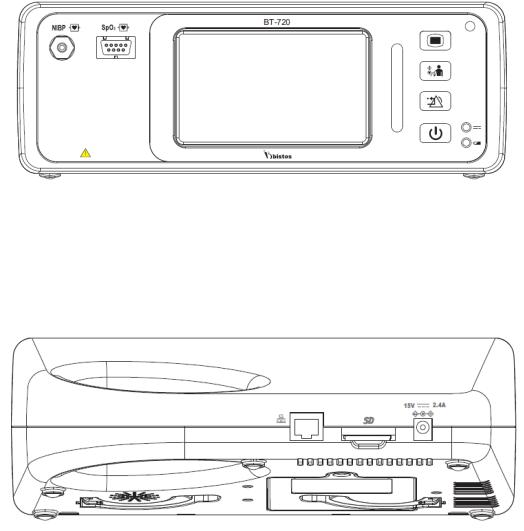
BT-720 Operation manual |
15 |
|
|
1.4 Product outlook
Figure1-1: Front view
Figure1-2 : Rear view
|
|
|
P/N : 720-ENG-OPM-EUR-R01 |
Bistos Co., Ltd. |
2019.06 |

BT-720 Operation manual |
16 |
|
|
1.5 Description of monitor
|
|
|
|
Figure1-3: Front view |
|
|
|
|
|
|
|
|
|
|
|
Name |
|
Description |
|
|
|
|
|
|
|||
|
|
|
NIBP tube interface. This is option. When you purchase |
|
||
1 |
NIBP |
the monitor only with SpO2, this interface will be |
|
|
||
|
|
|
blocked. |
|
|
|
2 |
SpO2 |
SpO2 cable interface |
|
|
||
|
|
|
|
|
|
|
3 |
Display area |
Display the waveform and measured value |
|
|
||
|
|
|
|
|||
|
|
|
Indicates the priority of physiological alarm and technical |
|
||
|
|
|
alarms in different colors and flashing frequencies. |
|
|
|
4 |
Alarm indicator |
- |
High priority: Red, fast flashing (1.4 ~ 2.8 Hz) |
|
|
|
|
|
|
- |
Medium priority: Yellow, slow flashing (0.4 ~ 0.8 Hz) |
||
|
|
|
- Low priority: Yellow, constant on |
|
|
|
5 |
|
Enter to the setting mode. Press again to close the setting |
||||
[Setting] |
mode. |
|
|
|||
|
|
|
|
|||
|
|
|
Start and stop the non-invasive blood pressure |
|
|
|
6 |
[NIBP] |
measurement manually. This is option. When you |
|
|
||
|
|
purchase only with SpO2 this button will be deleted. |
|
|
||
7 |
[Alarm reset] |
To reset the alarm condition. |
|
|
||
|
|
|
|
|
|
|
8 |
DC power indicator |
Turned on when the monitor is being powered by the |
|
|
||
adapter. |
|
|
||||
|
|
|
|
|
||
|
|
|
- On: The battery is being charged or has been fully |
|
|
|
|
|
Battery indicator |
|
charged. |
|
|
9 |
- Off: The battery has not been installed. |
|
|
|||
|
|
|
- Flashing: The monitor is being powered by the |
|
|
|
|
|
|
|
battery. |
|
|
|
|
|
- Power On: Press down the key more than 2 seconds. |
|
||
10 |
|
- Power Off: Press down the keys more than 2 seconds |
||||
[Power] |
|
and the system will display the alarm message “The |
||||
|
|
|
||||
|
|
|
|
system will shut down 3 seconds”. |
|
|
|
|
|
|
|
|
|
|
|
|
|
|
|
|
P/N : 720-ENG-OPM-EUR-R01 |
|
Bistos Co., Ltd. |
2019.06 |
|||
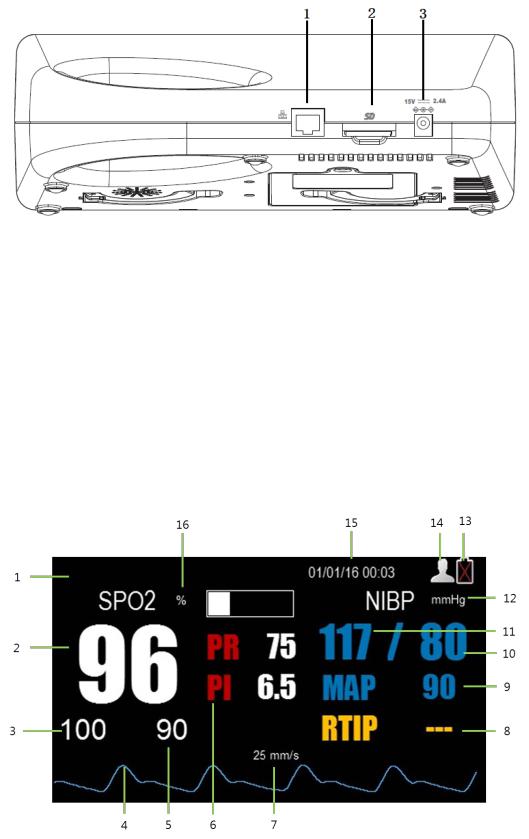
BT-720 Operation manual |
17 |
|
|
Figure1-4: Rear view
|
Name |
Description |
|
|
|
1 |
Network port |
For CMS |
|
|
|
2 |
SD card interface |
For software upgrade |
|
|
|
3 |
Power adapter |
15V, 2.4A adapter |
|
|
|
1.6 Understanding the display
Figure 1-5: Standard display
|
|
|
P/N : 720-ENG-OPM-EUR-R01 |
Bistos Co., Ltd. |
2019.06 |
